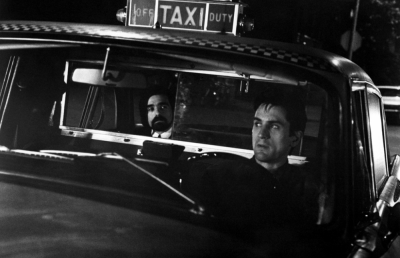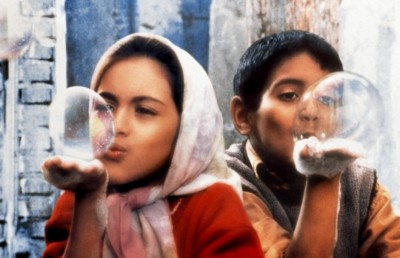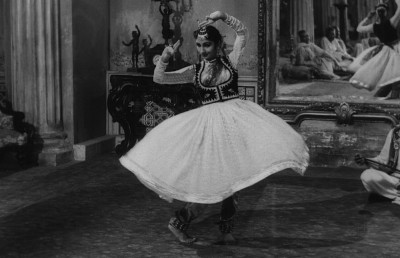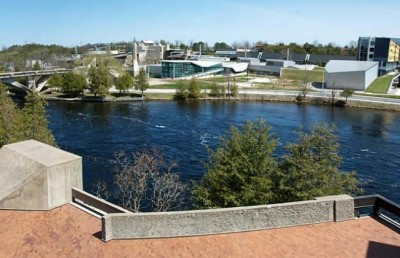Asian Potpourri
Iranian Films at FCMM 1997
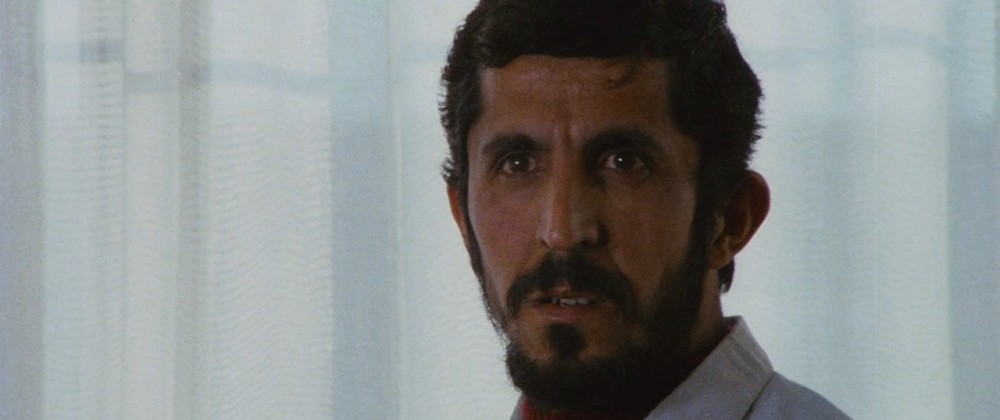
Photo Source, Criterion Pictures
(The following 4 Iranian films/videos played at the 1997 edition of Montreal’s “Festival of Cinema and New Media.”)
- Close-up, Long Shot
- Mahmoud Chokrollahi, Moslem Mansouri, 1996, France, 44 min., video
- Reverse Angle
- Maani Petgar, 1996-97, Iran, 33 min., video
- Point of View
- Maani Petgar, 1997, Iran, 11 min., video
- Unspoken Words
- Iraj Karimi, 1996, Iran, 35 min., video
Iran may have eclipsed Hong Kong and India as the movie-mad capital of the world. By this I mean an over-all obsessive interest in film that spreads from filmmakers to film viewers, from popular cinema to art cinema, from buffish literature to theory. This obsession is evident in the treatment of reflexivity found in the film’s of contemporary Iranian masters Abbas Kiarostami and Moshen Makhmalbaf. Kiarostami’s “trilogy” ( Where is My Friend’s Home? 1987, And Life Goes On… 1992, and Under the Olive Trees 1994) coyly plays with notions of narrative, reflexivity and fiction/documentary. His Close-up (1990), described by Werner Herzog as “the greatest documentary on filmmaking I have ever seen,” tells of a fascinating “fait divers” which in itself says much about Iran’s mad-love affair with cinema. The film recounts the true story of a frustrated 42 year-old film buff, Ali Sabzian, who dupes a family into thinking that he is director Moshen Makhmalbaf scouting for a potential family to cast in his next film. Sabzian, while never menacing, exploits the family’s gullibility and ingratiates himself into their household. Close-up is a documentary on the duplicitous would-be actor Ali Sabzian. Unlike its progenitor, Close-up, Long Shot does not play with questions of reflexivity or fiction/non-fiction, but is a straightforward “talking head” examination of the phenomenon behind a man obsessed with cinema beyond all rational measures.
Though formally uninteresting, the video manages to slowly draw us into Sabzian’s psyche with its minimalist palette (no music, no camera movements), and probing long take close-up’s of Ali Sabzian. What starts off as an outsider’s look in (interviews with co- workers, neighbors) ends up being a probing, at times Freudian self-examination. Sabzian, formally uneducated and accused as such by some of the earlier interviewees, comes across as being extremely perceptive, intelligent and very clever concerning notions of social culpability (Sabzian underscores the irony in his situation by noting how people around him, Abbas Kiarostami, Moshen Makhmalbaf, the media, the family, are all willing partners, and how he is a “victim of cinema”).
In the film’s final minutes Sabzian pours his heart out to/for the camera. He says that his irrational act is a testament to his love for cinema: “I spent the best days of my childhood in the dark…perhaps the adult in me is tired, but it listens to the child….I am physically small, but spiritually big.” His fanatical religious-like devotion to the cinema seems to have eclipsed family, friendship, and work. The video raises some interesting questions concerning the nature of obsession and the delicate, unformed line between acceptable and non-acceptable obsession. His sister may be exaggerating when she says that 80% of people in Iran are like him, but the Ali Sabzian phenomenon is surely representative of a cinema craze that is an integral part of Iranian culture.
{media_2}
Reverse Angle is a reflexive documentary on the filmmaking process that exhibits an “acceptable” form of cinema obsession: cinematic allusion and intertextuality. Director Maani Petgar takes his video camera to the set of an unnamed British/Australian co- production. The images, taken mainly at dusk, are in themselves not interesting. The camera remains usually at a distance, panning left to right quietly capturing the hustle and bustle of a film set. Crew members scurry about: carpenters, gaffers, special effects people. The film’s meaning, however, suggested in its already reflexive title, comes about through a discourse between the image and the soundtrack. Petgar layers the soundtrack with sound bites from selected auteurist and modernist films and directors. Most of the sound bites (there are a few film clips too) express lofty aesthetic or philosophical ideals on cinema, which contrast to the mundane, pragmatic reality (nuts and bolts) of the filmmaking process that the camera records: cinema-making versus cinema-thinking. For example, the first sound clip we hear is an Andrei Tarkovsky quote (on film and time) taken from the documentary Directed by Tarkovsky ,(Michal Leszcylowski, 1988) while the camera slowly pans past crew members mulling about in-between camera set-ups.
The selection of clips (visual and aural) reveals much about Petgar’s own taste, but also of a broader Iranian interest in art cinema. Many of the clips are taken from classics of reflexive, intertextual cinema: Stardust Memories, The State of Things, Sunset Boulevard, Burden of Dreams, Tokyo-Ga . The first film clips we see are from, in order, Blow-Up, Je Vous Salue Marie and Paris, Texas . The choice and order is not arbitrary. They denote the chronology of the three (arguably) most important modernist narrative filmmakers: Michelangelo Antonioni, Jean-Luc Godard and Wim Wenders.
The two other video’s, programmed with Reverse Angle , are forgettable. Point of View , also by Petgar, is a minor work where we are subjected to a series of vistas all taken from the high angle vantage of a window (I assume it to be from the director’s apartment). People waiting down below for a bus, walking across the street, you get the (dull) picture. Unspoken Words is the single fiction work. Director Iraj Karimi introduced the video as an attempt to capture the emotion of “mourning.” Stylistically, he was influenced by the films of Kryzstof Kieslowski and strived for “realism with a touch of metaphysics” (again, we see the influence of modernism/art cinema on Iranian filmmaking).
The story is about a husband and wife who are not on speaking terms and communicate through their son, Sami. The father and son are both killed in a car hit, leaving familial emotions unresolved. The father and son return as wandering ghosts, moving silently in a zombie-like state, while the wife mourns on. In the end a mysterious letter from the husband helps to alleviate some of the unresolved emotion and pain. Though there are a few nice touches (preponderance of subjective point-of-view shots after the double death to emphasize the wife’s isolation; use of widescreen ratio), the video relies on too many cliche effects to achieve its maudlin emotions (unstated love, unresolved emotions). For example, a (too quick) cut to the son’s ball bouncing down the street to stand-in for the car crash/death. Fritz Lang used this type of synecdochic cut much better way back in 1930 in M (a balloon rather than a ball)! All in all, Close-up, Long Shot merits viewing, especially if you’ve seen Close-up , while Reverse Angle will at least keep you guessing at the origin of the sound bites. Salaam cinema.
Wolves (1988) Sabir Nazarmuhamedov, Uzbekistan
Soldier’s Fairytale (1989) Zufikar Moussakov, Uzbekistan
Last Holiday , Amir Karakulov, Kazakhstan, 1996
Ma Vie sur la Bicorne (1993) Ermek Shinarbayev, Kazakhstan
If these four films are any indication of the mood within the Central Asian, ex-Soviet states, then solemnity is a state to strive for. The sense of despair, futility and meaninglessness shared youths in these films make Generation X’ers seem like corporate go-getters. Uzbekistan is the largest (population wise) of the Central Asian ex-Soviet states (Kazakhstan, Turkmenistan, Kyrgyzstan, Tadzhikistan), though little is heard about this nation on the film front. Both Uzbekistan films are decidedly grim in their depiction of the future. In Wolves a weak economy gives rise to a thriving Black Market (vodka, food), gambling and prostitution. A desperate 17-year old boy becomes embroiled in a cocaine ring. The film begins in a high key, realistic style but becomes more subjective as the boy’s future becomes shorter. It concludes with a dramatic moment of irony. The boy steals two packs of cocaine from a suitcase stored in a public locker. Two other men are accused of the crime and their subsequent deaths weigh heavy on the boys conscience (hence the many subjective moments: the shooting of the bartender in repeated montage, the face of the other man superimposed in the locker). In the final shot he spoils the last bag of cocaine and walks away from the camera; in a matter of seconds the empty foreground of the frame is filled by the large bulk of the two assassins. They begin to walk after the boy. Cut to the boy. He turns to face his executioners and the image comes to a freeze frame.
The second film leaves a deeper trench (or wound) in the memory because its form matches the darkness of the subject matter. The first half of the film takes place at a military base. We are soon witness to senseless violence that stems from pent up energy, social isolation and social stagnation felt by the soldiers. A group of bored soldiers take reprieve for a night on the town, but the night turns to tragedy. A frustrated soldier, angered by an earlier physical humiliation at the hands of a bully, seeks revenge by throwing a rock at the unsuspecting bully from a bridge. Instead the thrown rock hits his meek friend. Like Wolves , the final image encapsulates the sense of futility: the camera is in long shot range, the time is dusk. The figure of a soldier carrying a corpse enters the frame left. As he cuts across the frame we hear a voice-over letter written by the dead soldier to his wife describing his happy condition.
Last Holiday is set in 1979, when Kazakhstan was still part of the Soviet Union. It’s narrative is sandwiched between the sardonic opening and closing footage of Party Youth members celebrating the glorious Red Army and State Communism (May Day). The post-credit sequence then zooms-in to the window of an apartment complex and then cuts into the room, where a motley group of ethnically mixed male teenagers earnestly drink booze and smoke pot. Out of the bunch will emerge three central characters, Karim (Kazakh), Jacob (Jewish), and Valera (Russian). In the next scene some of the teens leave the building and walk across an ice rink. A few shots later snow is nowhere to be seen. Is the abrupt change in season a reflection of adolescent aimlessness?
The film’s title is ironic, since nothing remotely celebratory happens in the film. What transpires is a lesson in hopelessness where a harmless crime (stealing a bass guitar and amplifier) leads to a senseless violent murder. The only positive element in the film is the sense of solidarity among the three rootless friends that, ironically, grows out of the act of violence. His crass stepfather exposes Valera’s crime and Valera is soon picked up by the police. When Jacob and Karim learn of the traitorous act, they brutally knife the stepfather in a gut-wrenching elevator scene. Valera tries to escape from his police guards, but is rundown, brutally beaten up and tossed out of the police car to die. Jacob andKarim come across Valera’s beaten body and try in vain to nurse him to health. The situation gives the teens a temporary sense of purpose and solidifies their sense of group loyalty. By this point in the film, after a stream of unsympathetic authority-adult figures (vigilante police, abusive stepfather, corrupt drug pusher) the original act of senseless violence perpetrated by the two teens, as heinous as it was, is placed into an ironic social and cultural context. The film ends with no sense of hope. Valera dies, Jacob gives himself up to the police and Karim joins his schoolmates in the playground for another “glorious” march. The futile circle is closed.
Like other films from Kazakhstan, such as Ma Vie Sur la Bicorne (1993), Last Holiday is marked a cinematic style that could aptly be referred to as “aimless realism.” Ma Vie Sur la Bicorne begins similarly to Last Holiday , with an extreme long take of two young men smoking up. The central character, in his late teens, spends his time abusing his body with alcohol, drunks, cigarettes (usually with a friend. He has some talent –poetry, guitar– but doesn’t see the point or meaning in life (His friend quotes him Nietzchse’s not-too-comforting dictum that life is its own meaning). It’s also hard to understand why such beautiful women waste their time with him.) Apart from this, nothing much happens in the film. Narrative aimlessness matches character aimlessness. Ma Vie Sur la Bicorne is a film which succeeds (too?) well in making the audience feel as the central characters do: bored. Early on the film has a nice visual dialectic in the varying grain and stock but this gives way to a more singular look. Until the final scene where, through a window screen, we see people playing in the park in the background and the lead character in the foreground. The background is unclear, cut off from the foreground image, suggesting an emotional separation. More interesting is the use of the soundtrack. Again dialectally, while not much goes on in the visual sense, the soundtrack is busy with off-screen sounds, voices and noise, and creates a tension that would not exist in the image track alone. Toward the end of the film the teenage lead nearly succeeds in killing himself with drug overdose. Somehow he survives and the film ends with him watching, of all films, Pasolini’s Salo: 120 Days of Sodom with a group of equally lost people.
Paradise Sergey Dvortsevoy, Russia, 1995, 23 min.
Paradise is a multi-prize winning ethnographic documentary set in a nomadic shepherd’s camp in the Southern mountains of Kazakhstan. The film’s title’s gives evidence to a healthy dose Kazakhstan-style irony. Surely, at least for an urban dweller, the painfully quotidian lifestyle depicted in Paradise is probably not the average person’s vision of paradise. But if the filmmaker’s point is to rigorously underscore the beauty in simplicity and everyday life, then Paradise succeeds in spades. Paradise is comprised of 30 (mainly) melancholic sequences of Kazakh farm life. Each of the sequences constitutes an important aspect of farming life, yet they are not linked in any structural or thematic way. This undoubtedly underscores the film’s attempt to recreate the rigorously unhurried sense of life on this shepherd’s camp. There is never a sense of urgency in the sequences once we are in them, nor in leaving them. This pace is established right from the remarkably engaging opening sequence of a little toddler sitting legs spread on the hut floor eating sour cream (or yoghurt). The camera captures him in full body, in static long take. He never acknowledges the camera’s presence (this sense of camera ease is largely due to director Dvortsevoy having filmed over a fairly long three month period). The boy is intense in his eating style. Half the food ends up on his mouth and jacket. The loud sound of a buzzing fly fills the air. Throughout, the boy conducts himself with curiously adult gestures and sounds. He begins to groan, seems to lose his precariously negotiated balance and slowly topples over backwards. He falls asleep. Only then does the camera cut away from this uneventful but thoroughly captivating moment.
Most of the sequences work in the same way, some humorous, some painful, some merely instructive. In the next sequence an ungainly cow (or is that an oxymoron?) gets his head stuck in a milk can. The frustrated cow runs straight into a nearby bin, sending a cavernous sound crashing into the theatre. (imagine something farmer McDonald would send to FUNNIEST HOME VIDEOS) In a sequence that had some people squirming, the camera graphically and unflinchingly records a farmer performing “corrective” surgery on a camel to place a permanent nose hitch in his snout.
The film is all of one piece. The effectively minimal visual landscape, wind beaten steppes, barren vistas, shanty huts, is echoed by the sparse soundtrack of wind, snoring, and buzzing flies. I guess according to director/producer Sergey Dvortsevoy, “paradise” is in the eye of the beholder…or perhaps, “paradise” is a nice place to film, but I wouldn’t want to live there.



